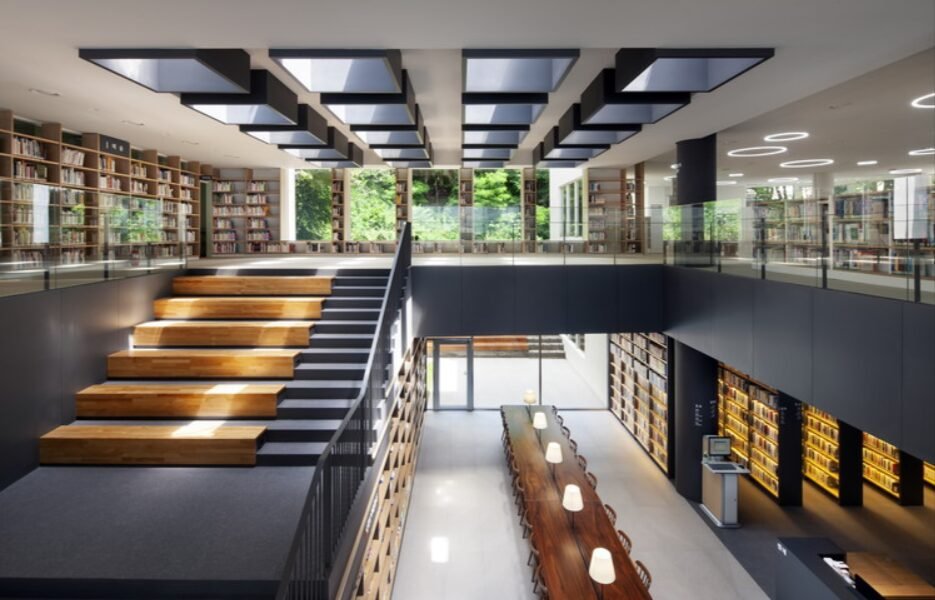
library interior design
In a city known for its tech-first mindset, Bangalore’s academic institutions are embracing a new wave of evolution—digitally enhanced learning environments. At the heart of this transformation lies one of the most traditional spaces in education: the library. No longer quiet, paper-only sanctuaries, libraries are becoming vibrant, tech-integrated hubs where digital access and collaborative learning thrive.
This blog explores how library interior design plays a critical role in integrating digital learning within Bangalore’s school, college, and institutional libraries—ensuring students have access to both knowledge and the tools to engage with it.
Why Digital Learning Integration Is Essential in Bangalore
With a massive student population, a thriving tech sector, and an ecosystem of ed-tech startups, Bangalore is uniquely positioned to lead the shift toward hybrid and digital education. But for digital learning to succeed, it needs more than devices and software—it needs the right physical infrastructure.
Libraries, being central academic spaces, must evolve to:
- Support device-based learning and research
- Encourage collaboration without noise pollution
- Enable seamless tech access (Wi-Fi, charging, projection)
- Remain flexible for future upgrades
That’s where intelligent interior design becomes a strategic enabler.
Design Principles for Digitally-Ready Academic Libraries
- Zoned Layouts for Hybrid Learning
Modern libraries are no longer one-size-fits-all. The key is to create multiple zones:
- Silent zones for individual research
- Collaborative pods with screens and whiteboards
- Tech-enabled lounges with tablet docking
- Digital reference areas with catalog kiosks and databases
Flexible zoning supports varied learning styles and tasks—essential for today’s hybrid learners.
- Technology-Integrated Furniture
Designing for digital learning means rethinking even the furniture:
- Tables with built-in power outlets and USB ports
- Chairs with ergonomic support for long screen sessions
- Smart podiums and lecterns for virtual seminars
- Lockable device storage stations for student convenience
These features reduce physical barriers to using tech effectively.
- Smart Lighting & Acoustics
Poor lighting and echo-heavy spaces can degrade the digital learning experience.
- Use adaptive lighting systems that adjust to screen-based work
- Incorporate acoustic panels, carpeting, and soft dividers to control noise in group areas
- Provide quiet booths or “focus pods” for video learning or virtual tutoring sessions
These elements help students concentrate in tech-rich environments.
- Interactive Digital Surfaces
To foster innovation and collaborative thinking:
- Install touchscreen walls for interactive maps or concept brainstorming
- Integrate digital whiteboards in study zones
- Use projection walls for research presentations or guest lectures
This turns the library into a participatory space, not just a passive one.
- Future-Proofing for Ed-Tech Integration
Design Arc Interiors believes in scalable design. As new tools emerge—VR headsets, AI research platforms, AR-enhanced learning—spaces should be:
- Modular and adaptable
- Equipped with strong electrical and network backbones
- Built with concealed conduits for easy tech upgrades
This ensures the space evolves with the pace of technology.
Bangalore-Specific Needs & Opportunities
- Space Optimization: With real estate constraints in urban campuses, digital libraries must be designed compactly yet efficiently.
- Local Ed-Tech Integration: Many Bangalore-based institutions are partnering with local startups—design should accommodate demo pods or test zones for such tools.
- Sustainable Infrastructure: Energy-efficient lighting, passive ventilation, and low-emission materials are essential for long-term academic infrastructure.
Conclusion: Design as a Catalyst for Digital Learning
Bangalore’s education sector is on the brink of a digital renaissance. But technology alone isn’t enough—space must support and enhance digital engagement. Interior design plays a silent yet powerful role in enabling smoother transitions to hybrid learning models.
At Design Arc Interiors, we bring together architectural insight and digital foresight to create academic spaces where technology and design empower learners together. Whether it’s a school library, university resource center, or institutional knowledge hub—we design for the future of learning.





More Stories
Is Sansui an Indian Company? True Or Not
Handles Salary Revision and Appraisal: 10 Fact
Is Walmart an Indian Company? True Or Not